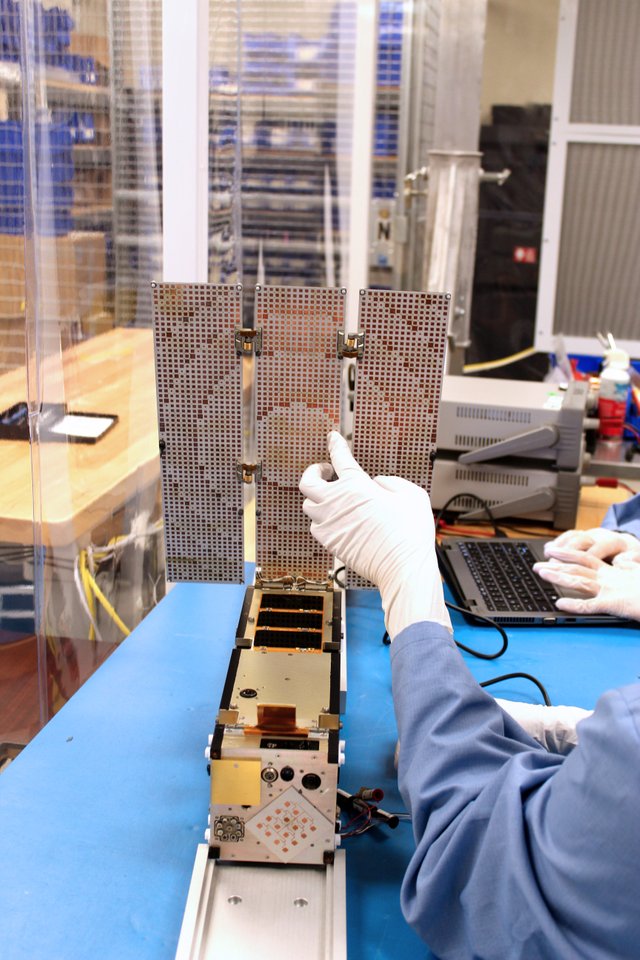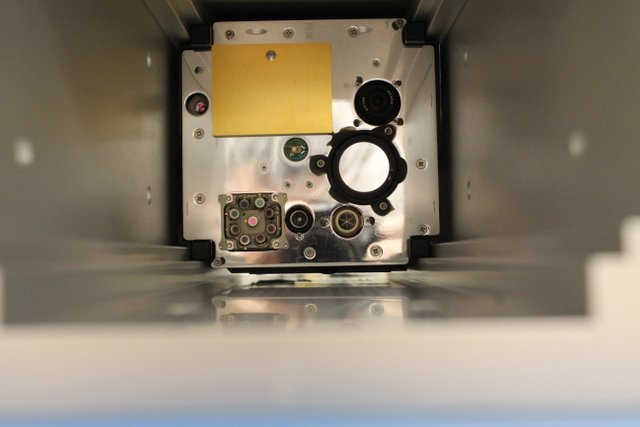NASA CubeSat Missions: Pushing the Boundaries of Technology
Credits: Nanoracks
ISARA’s three antenna panels feature a printed circuit board pattern that narrowly focuses the CubeSat’s radio transmission beam in much the same way a parabolic dish reflector does.
Credits: Nanoracks
The OCSD communication face of the satellite shows the major communication systems such as those of the laser transmitter and emitter, radio frequency antenna, and other sensors.
Credits: Nanoracks
NASA’s Small Spacecraft Technology Program is on the countdown clock to advance communications and proximity maneuvering capabilities for CubeSats with two separate technology demonstration missions.The Optical Communications and Sensor Demonstration (OCSD) mission will showcase the first-ever high-speed data downlink from a CubeSat to a ground station using lasers, in addition to maneuvering the pair of diminutive spacecraft to up-close proximity.Also set for demonstration is the Integrated Solar Array and Reflectarray Antenna (ISARA) mission. A reflectarray is a relatively new type of antenna fabricated from standard printed circuit boards with an array of square copper patches etched on them.These innovative satellites were carried onboard Orbital ATK’s Cygnus advanced maneuvering spacecraft, a commercial resupply vehicle that will berth to the International Space Station (ISS). Atop the Orbital ATK’s Antares booster, the Cygnus commercial resupply mission launched from NASA’s Wallops Flight Facility in Virginia on Nov.12.Once the Cygnus craft has completed its ISS servicing mission, it will detach from the ISS and move to a higher orbit. From there, the OCSD and ISARA CubeSats will be deployed to begin their respective missions.The Small Spacecraft Technology Program expands U.S. capability to execute unique missions through rapid development and in-space demonstration of capabilities for small spacecraft applicable to exploration, science, and the commer¬cial space sector. The program enables new mission architectures through the use of small spacecraft, with goals of expanding their reach to new destinations and challenging new environments.Precision pointing
“Our primary mission for OCSD is demonstrating laser communications, by using a laser on the spacecraft to downlink data to our optical ground stations on Mt. Wilson in California. The laser communication data rates are orders of magnitude higher than what we can do in radio frequency,” explains Richard Welle, one of the principal investigators for OCSD at The Aerospace Corporation in El Segundo, California, that manages the project.“Laser communication offers data rates competitive with current high-end CubeSat communications systems, in a compact package, and with the potential to go to much higher rates yet,” Welle notes. With each spacecraft carrying ultra-small star trackers, critical for precision pointing of the laser communications hardware, the laser is hard-mounted to the individual CubeSat body with the beam pointed by controlling the orientation of the entire spacecraft.“Building a laser that would work in this environment meant solving a number of technical challenges,” Welle advises. But having solved those challenges, he continues, the result was having a laser system much more compact than anything previously flown in space.Applications for high data rate communications include providing download capability for data-intensive missions in low-Earth orbit such as those engaged in Earth imaging.Close cousins
Following laser communication testing, another OCSD objective is proximity operations where the two CubeSats will fly relatively close together in Earth orbit. To do so, the satellites use a combination of variable drag and bursts of propulsion from the spacecraft – using water exhausted as steam – to bring the two within 650 feet (200 meters) of one another.Both CubeSats have miniature cameras, laser rangefinders, and are dotted by light-emitting diodes (LEDs) to aide in a step-wise reduction of distance between them, Welle explains. “The plan is to essentially have one of the satellites orbit the other at smaller and smaller distances,” Welle adds.Each OCSD CubeSat is about 4 inches x 4 inches x 6.7 inches (10 centimeters x 10 centimeters x 17 centimeters) and weighs approximately 5 pounds (2.5 kilograms).As for the benefit of CubeSats, Welle is confident on what’s already been learned in the OCSD project. “The technology development aspect of this mission is proving worthwhile for follow-on missions. Also, the commercial sector is very interested in the technologies that come out of this work,” he concludes.Capabilities in proximity operations will enable multiple small spacecraft to operate cooperatively during science or exploration missions, to approach another spacecraft or object for in-space observation or servicing, or to connect small spacecraft together to form larger systems or networks in space.Data-downlink
The technology benefit of the ISARA mission is to enhance CubeSats with a blend of antenna and solar cells, to allow for higher data-downlink communications. ISARA will use radio frequency Ka-band – the first time Ka-band uses a reflectarray antenna– that will surpass the existing baseline CubeSat transmission rate of 9.6 kilobits per second to more than 100 megabits per second.“We have a lot of mission firsts with ISARA,” says Richard Hodges, principal investigator of this CubeSat mission at NASA’s Jet Propulsion Laboratory (JPL) in Pasadena, California. As a devoted “antenna guy” with decades of experience, he sees a bright future for the integrated solar array and reflectarray antenna that was perfected by JPL technologists.“This is a flat antenna style, effectively replacing an antenna such as the curved surface parabolic style. Thanks to a photolithographic etching process, the reflectarray is relatively inexpensive to produce and they are lightweight. Furthermore, this type of antenna makes very efficient use of CubeSat volume. And that means lots of added room for payloads, such as science instruments or imaging systems,” Hodges observes.To the best of his knowledge, ISARA will be the first in-space demonstration of a reflectarray antenna as well as that of an integrated antenna and solar array. “As far as we know, no reflectarray has ever flown in space. It has been discussed over the years, but now we’re going to demonstrate it does work in the space environment,” says Hodges.Sweet spot sendoff
Distinct from a parabolic dish antenna, the flat reflectarray panels are folded down flush against the CubeSat. Once the three antenna panels are deployed – electrically tied together through hinges – they narrowly focus the CubeSat’s radio transmission beam to a “sweet spot” in much the same way a parabolic dish reflector would, Hodges explains. “ISARA’s solar array and reflectarray antenna is a very attractive package that enables high-speed data rates of more than 100 megabits per second. That’s our primary goal for this mission.”Signals from the reflectarray antenna are to be transmitted to a ground station located at NASA’s JPL. Experts there will reconstruct the antenna signal pattern, contrasting that pattern against pre-launch ground tests to appraise overall quality of ISARA’s downlink transmission over months of mission duration.The ISARA mission is being carried out in partnership with The Aerospace Corporation (Aerospace). Aerospace built the CubeSat and also supports a ground station network that’s spread out across the United States that can be used to support the CubeSat demonstration flight.Stowage efficiency
Hodges highlights other ISARA flight firsts, including antenna gain measurement actually done in space. “There’s quite a significant list of technology advancements, like use of off-the-shelf camera sensors for weather and environmental monitoring,” he says.Indeed, due to efficiencies in the ISARA design that provide extra stowage volume, along with spacecraft power provided by ISARA technology, a secondary payload known as the CubeSat Multispectral Observation System (CUMULOS) is onboard - an experimental remote sensing payload from Aerospace.“We’re very excited about what ISARA can enable, both in science data transmitted down from Earth orbit, and for deep space exploration missions too,” Hodges forecasts.Infusion into the future
The path forward for CubeSats is underscored by Elwood Agasid, deputy program manager of the Small Spacecraft Technology Program at NASA’s Ames Research Center in Silicon Valley, California.“These two missions are pushing technology forward, for infusion in future missions. Getting data down to the ground from space is always essential. Laser communication and improvements in CubeSat radio frequency communication will be key components of that future. Similarly, flying smallsat constellations are important as well,” says Agasid, as is new antenna technology.ISARA and OCSD reflect how essential small satellites have become. “The short period of development time, the frequency of flight opportunities, and the ability to fly hardware in space to see how it performs in a relevant environment – these small satellites give us a low-cost avenue for in-space validation, verification and improvement of technology in an incremental fashion,” Agasid concludes.


